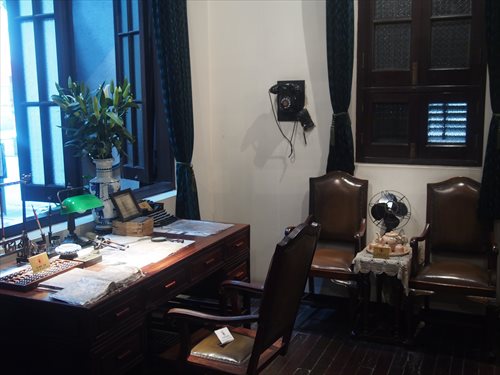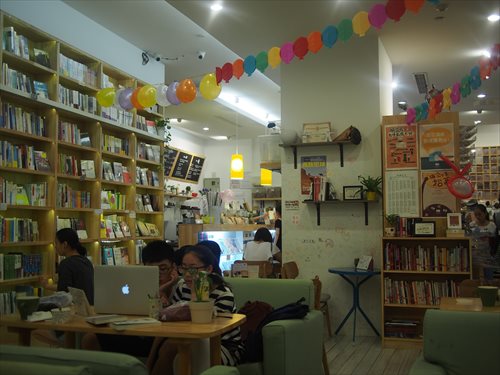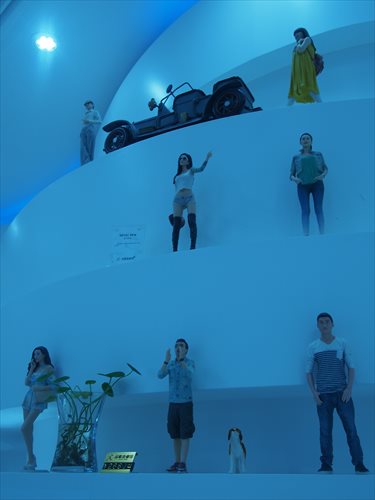Xintiandi station
More than just shopping and nightlife on offer at city's famous landmark
Editor's Note
This year is the 21st anniversary of the opening of the Shanghai metro. The subway has facilitated more than 13 billion journeys during its 21 years, and half of Shanghai citizens cite the metro as their favored mode of transport. To commemorate the anniversary, each week the Global Times will take an in-depth look at one metro station and its surroundings. In the case of downtown stations, we will focus on points of interest within walking distance; while for suburban areas, we will cast our net a little wider.
Xintiandi Station on metro Line 10 is right at the heart of Shanghai's urban charm. Exit 6 brings one out to the northern part of Madang Road, which joins with a number of charming lanes including Xingye Road and Taicang Road. Together, they present the city's tourist icon and premium entertainment area of Xintiandi, with its exquisite cafes, restaurants, boutiques shop and signature architecture.
While shopping and dining are what most people come here for, there is certainly plenty more on offer.
To begin with, there are as many as three museums nearby. Shikumen Open House Museum (No.25, Lane 181 Taicang Road) and the Xintiandi branch of the Shanghai Postal Museum (No.3, Lane 123 Xingye Road) let visitors explore the local cultural heritage and communication development, while the Museum of the First National Congress of the Chinese Communist Party (76 Xingye Road) presents an important chapter in modern China's political history.
Shikumen Open House Museum
Shikumen Open House Museum (pictured below) in the midst of Xintiandi regularly gets glowing reviews from visitors.
Shikumen housing is a type of residential building unique to Shanghai. The style appeared around the mid-1800s and became common in the early 20th century, before the demands of modern development led to large-scale demolition of shikumen complexes. Now their number is relatively few.
The main venues of Xintiandi are renovated shikumen buildings constructed around the 1920s. The museum showcases what the housings might have been like before they were adapted to commercial use.
The museum spans over three stories and more than 360 square meters, and simulates the interior of a shikumen residence from layout, furnishings and decor to details such as the books on the shelves and family pictures. "There is no particular prototype for this museum, but it is representative of a middle-class family's dwelling in old Shanghai," a staff member at the museum told the Global Times.
While there are few illustrations providing background information and relevant stories in the rooms, there are guided tours available from the curator and volunteers from local universities. The museum opens between 10:30 am and 10:30 pm daily. Adult tickets are 20 yuan ($3.22), while entry for seniors aged 60 or above and children aged 3 to 12 costs 10 yuan.

Momicafe Bookstore
Although it's a busy center of shopping, Xintiandi also offers nice and quiet places for reading. One good choice is Momicafe Bookstore (pictured above) on the B1 floor of the Xintiandi Style shopping mall (245 Madang Road).
The bookstore chain originating from Suzhou now has four outlets in Shanghai. The Xintiandi store is not only a local favorite but also one of the three best performing of the 20-plus outlets nationwide.
As well as Chinese bestsellers and classics of world literature, there are also travelogues and books on art and design available, among other genres.
Moreover, weekend events at which the public can meet popular writers are held, usually Sundays, every couple of weeks.
A feature of the bookstore is its wide collection of postcards. Some are exclusive to the store, while others are based on popular designs.
Momicafe offers postcard delivery at any date within the next 10 years and customers are invited to put their written messages into mailboxes bearing the number of the year. A calendar-like shelving unit occupying one wall, meanwhile, stores postcards that will be sent within the remaining days of the year or earlier next year.
Customers can read and write postcards, or simply chill out at the wooden tables and in comfortable sofas. Quality coffee, tea and snacks keep them in good company.

Pinla-3D
The area's appeal and fun also lies in its innovative treasures of which Pinla-3D, the country's first 3D printing shop specializing in making human models, is a highlight.
"3D models, unlike photographs, are still novel to people and offer a bigger visual impact," a member of staff told the Global Times.
A 3D scanner records a customer from head-to-toe and a model is made accordingly within 10 to 15 days.
There are different sizes of model available to purchase. Of these, the biggest, a full-scale model, costs a hefty 170,000 yuan; the smallest, a 15-centimeter-tall model, costs 1,800 yuan.
Customers tend to be soon-to-marry couples, seniors being treated by their children, and kids. The most popular package here is the 12 Animals in Chinese Zodiac, catering to young children - the model of the child is embedded within a cartoon-like Chinese zodiac.

A display of the 3D models available at Pinla-3D Photos: Liao Fangzhou/GT